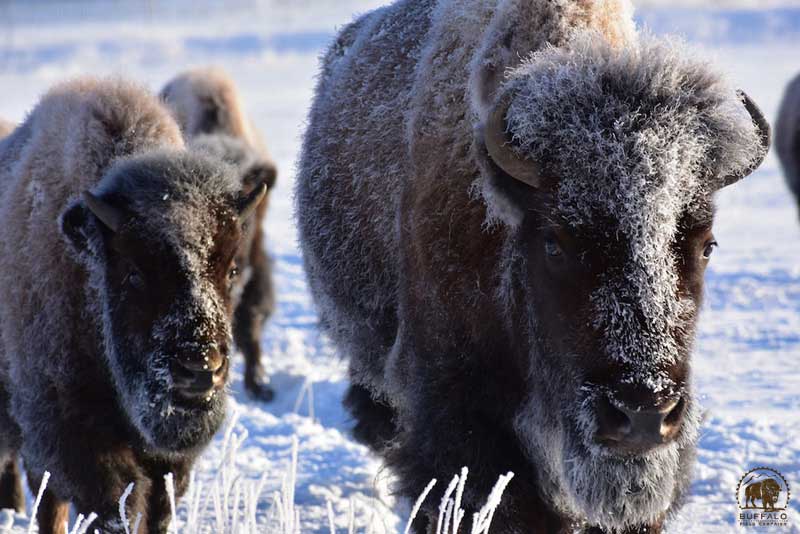
by Deep Green Resistance News Service | Mar 1, 2018 | Biodiversity & Habitat Destruction
Featured image: A single mom with seven calves who she is caring for. More than likely, only one of these calves are hers, and the rest of these babies are buffalo she adopted after their mothers were killed by hunters. BFC photo by Stephany Seay.
by Stephanie Seay / Buffalo Field Campaign
It’s just below zero as we trek through freshly fallen snow on an unusually windless early morning, in the high hills above the Gardiner Basin. Taking advantage of the calm air that won’t rock our scopes and cameras, our patrol is on the way to a lookout spot high above Yellowstone’s Stephens Creek buffalo trap. The trap is miles away. The spot we’re at is one of the few places that we can see even a far-away glimpse into the industrial size monstrosity that has entrapped more than 450 of the gentle giants in the past couple of weeks. Yellowstone initiates a massive seven-mile public closure around their trap, obviously wanting to hide the horrible things they are doing to this sacred species, our national mammal. On our way to the lookout, our footsteps squeaking through the freezing cold snow, one of our crew shouts out, “wolves!” We all stop dead in our tracks. To the south of us, we can hear them, the beautiful, haunting serenade of a wolf pack, singing blessing songs to the morning, or, more like mourning songs to the travesty unfolding before us. The wolves know. We get to the lookout spot and it’s as bad as we thought: hundreds of buffalo in the trap, huddled together, eating hay rations, trapped on death row. Four park wranglers on horseback, and a white SUV are coming into the northernmost paddock of the trap which holds approximately 60 of the country’s last wild buffalo. This paddock is the veritable end of the line before the buffalo go in even deeper, to places they will never return from.
“Genocide,” our Blackfeet brother says. We nod in agreement. The U.S. Government continues the systematic destruction of the sacred buffalo, and for the same reasons, too. Only, these days, instead of Buffalo Bill and Wild Bill Cody, they call it “management” and the killers are the so-called guys in green: Yellowstone National Park. Donning buffalo on their uniform badges, they are the very ones who are obligated to protect the buffalo — the buffalo who are the main reason this park even exists, that people even come here. These “caretakers” are facilitating all of the trapping and most of the killing. As we watch through our scopes and binoculars, eyes teary from the blistering cold, or the pain in our hearts, the wranglers go in for the attack. It’s just another day in the park. Frantic, the sixty buffalo run away from the wranglers, but the only path open to them is the dark corridor that leads into the labyrinth of the trap, towards the bull pen and the squeeze chute, towards the end of freedom and family, into the tiny holding pens where they will spend their last hours in feces and fear, before being loaded onto livestock trailers headed for the slaughter house. The mournful howling continues. The wolves know. We join in.
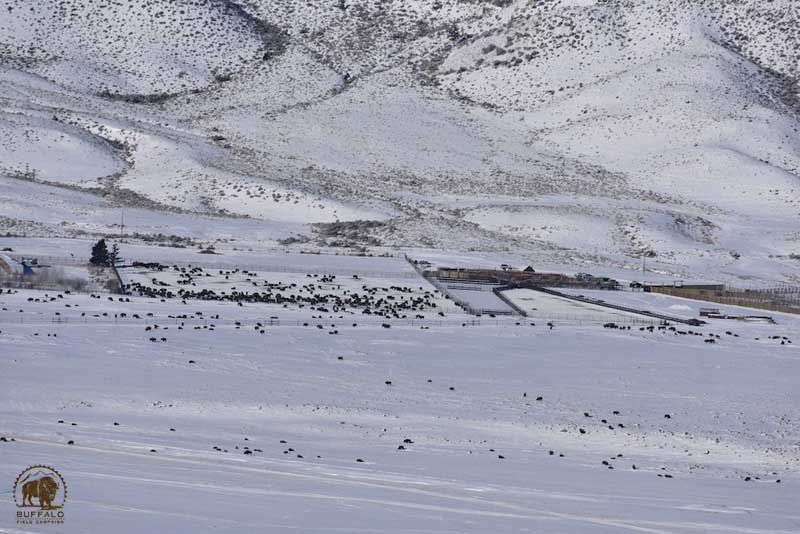
A bird’s-eye view of Yellowstone’s Stephens Creek buffalo trap. The massive closure is an attempt to keep the public from seeing what Yellowstone is doing. BFC photo by Stephany Seay.
Anticipating shipments to slaughter, the next morning we rise even earlier to get our sites on the trap before the trailers arrive. We are well ahead of schedule. Our presence, our vigilance is the only way for anyone to know what is taking place here, for anyone to know what is really happening to the buffalo. Once posted up, we send one patrol high into the hills for an even better birds-eye view. Even so, both lookouts rely on the powerful magnification of spotting scopes to see anything, and tiny-dot-anythings at that. With the naked eye, the trap and it’s happenings are hardly visible at all. The trap is so strategically located that Yellowstone’s shame and desire for secrecy are apparent. Just before dawn, multiple vehicles start arriving to the trap. The unmarked rigs of the wranglers, a few park service law enforcement officers, Yellowstone’s bison biologist, Rick Wallen, and others, get ready for another day of wild buffalo abuse. Then the stock trailers show up, flanked by law enforcement escorts. It takes less than an hour for them turn wild buffalo from sacred, free-born beings into “pounds on the hoof” headed for the slaughter house.
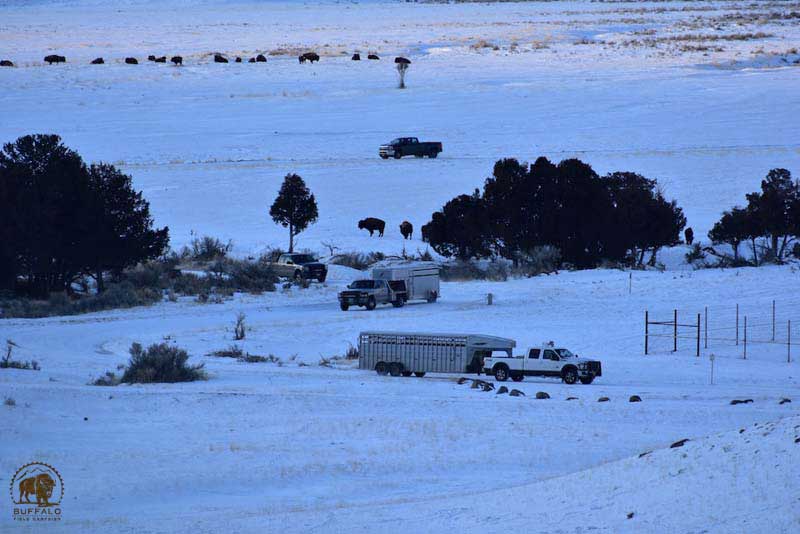
2018 03 01 03 003 Update3 Buffalo Field Campaign Stephany Seay 2018 800 Two stock trailers drive through Yellowstone, and groups of buffalo, taking buffalo who were captured at Yellowstone’s facility to slaughter on Wednesday morning. BFC photo by Stephany Seay.
The dominant culture — not even those who might care — can’t bear to look into the face of the reality of its actions. It views the human supreme; born out of a cold arrogance lusting for control, enabling the conversion of the living into the dead for profit. Forgetfulness, mindlessness – “with guns and laws and truth that lies” – help grease the gears of the machine; numbness is the key to conducting wildlife “management.” It is said that once you see, you cannot unsee. A self-inflicted blindness enables it —to see would break their hearts and force their souls wide open. So, with brutal efficiency, the government workers keep their blinders on, do their jobs, and hold fast to the agreed upon Interagency Bison Management Plan.
Approximately 450 wild buffalo have been captured in Yellowstone’s trap, and nearly 250 have been killed by hunters just across Yellowstone’s boundary. By Yellowstone and Montana’s own standards, the middle-end of their 600-900 kill quota — in place to appease Montana’s cattle interests — has already been met. After the last few weeks of extremely unsavory ‘hunting’ along Yellowstone’s north boundary, very few hunters have come to kill buffalo this week. Many have left here utterly disgusted, vowing never to participate in such a slaughter again.

With their enormous, shaggy heads, buffalo face into a storm. We have much to learn from our relatives, the buffalo. BFC photo by Stephany Seay.
Before and after bearing witness to this insanity, we are reminded of the real reason we are here. Other buffalo, who were not in the trap, gave us the gift of remembering and connection, the honor of being in their presence and living in the moment. They help us remember who we are fighting for — and with — and why. The buffalo help us connect with their humbling ancient wisdom; a truth so incredibly sacred because of its gentle simplicity and rightness.
The blizzard came in quick and heavy, and the buffalo moved right along with it as they always do. With their heads into the storm, grazing and walking, sparing and goofing around, they look up at us for moments with the eyes of god, the faces of ghosts, awakening memories of ages past and future potentials. Still here. Still present. Still doing what they have always done since buffalo time began. Where they walk, ravens feast on the gut piles of their recently killed relatives, strewn across the landscape at Beattie Gulch, a beautiful place that has become synonymous with death. And, yet, the buffalo still come, still offer life, staying among the living. Obstacles be damned. These ancient beings have survived Ice Ages; now the question is: can they survive the U.S. government? In the joy of sharing time and place with the buffalo, in our pain and anger fueled by management plans, being in the company of friends both human and buffalo recognizing each other, committing to each other again; in our solidarity among our comrades we understand that all of these things come from love. Profound love. The buffalo and their wildness, their teachings of sorrow and joy, their obligation to the earth, and ours to them. These realities keep awake our spirits, reaffirm and strengthen our vow: yes, you will survive, and we will give ourselves to make sure of it; fighting for you, along side you.
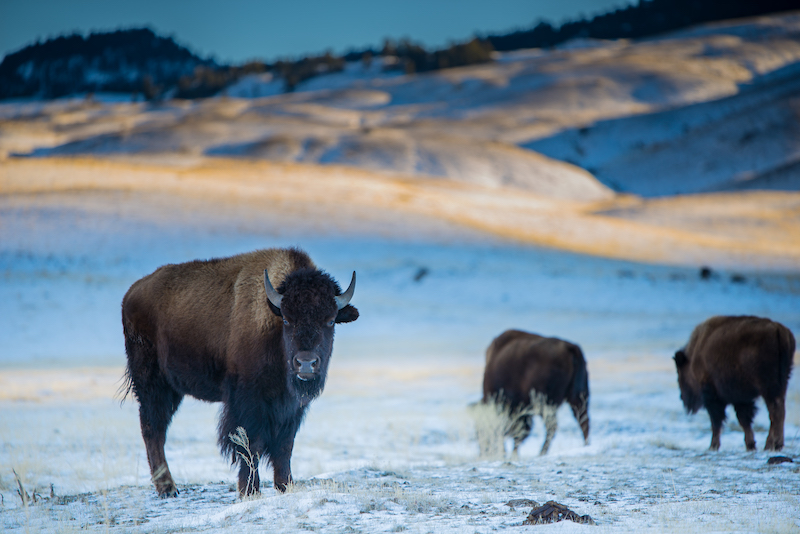
by Deep Green Resistance News Service | Feb 26, 2018 | Biodiversity & Habitat Destruction
by Max Wilbert / Deep Green Resistance
“One person died and another was badly burned when a gas well exploded here last year,” my friend Adam says, pointing to an oil well set back a hundred yards from the road. We’re on the plains beneath the Front Range in Colorado, where the Rockies meet the flatlands. Oil country. Wells and fracking rigs are everywhere, scattered among the rural homes and inside city limits.
I’m on my way home from volunteering with Buffalo Field Campaign outside Yellowstone National Park, and I’ve stopped in Colorado to see friends and learn more about the fight against fracking that’s going on here.
Adam explains to me that there are thousands of wells in the area, despite widespread opposition. Cities have passed laws against fracking, been sued by industry groups in response, and lost the lawsuits. Democracy is clearly less important than profits in the United States—but that’s no surprise to anyone who is paying attention.
#
A few days earlier, Buffalo Field Campaign held the first annual Rosalie Little Thunder memorial walk through Yellowstone National Park.
We walked 8 miles past “the trap” where Yellowstone National Park uses tax money to trap and send to slaughter wild buffalo, past APHIS (Animal and Plant Health Inspection Services) facilities where buffalo are captured, confined and subjected to invasive medical testing and sterilization, and past Beattie Gulch where hunters line up at Yellowstone’s boundary to shoot family groups of buffalo en masse as they walk over the Park’s border. As we walked, I watched two of Rosalie’s sisters holding hands as they walked together in honor of their sister.
Cresting a small rise, we came upon a group of more than a hundred buffalo, grazing and snorting softly to one another. As we approached the herd, indigenous organizer and musician Mignon Geli began to play her flute, accompanied by drums. As if they could sense the whispers from our hearts and the prayers carried in the music, the buffalo began to move south, further into the park and towards safety.
Safe for the moment. But by late March, that entire group may be dead. Yellowstone National Park workers—including biologists—will lure the buffalo into the trap, confine them in the “squeeze chute” for medical testing, and then ship them to slaughter. As I write this, there are about three hundred buffalo who have now been trapped, very likely including the one pictured above.
I’ve never seen a wild buffalo confined in a livestock trailer, but I’m told it’s a horrible thing. Some describe it as a metal coffin on wheels.
#
Earlier today, I gave an interview to a radio show. The host asked me about why Deep Green Resistance focuses on social justice issues in addition to saving the planet. My response was to quote my friend, who explained it more concisely than I ever could when she said, “all oppression is tied to resource extraction.”
In other words, racism doesn’t exist just for the hell of it. It was created (and is maintained) to justify the theft of land, the theft of bodies, the theft of lives. Patriarchy isn’t a system set up for fun. It’s designed to extract value from women: free and cheap labor, sexual gratification, and children (the more, the better).
I wrote earlier that protecting the buffalo requires dismantling global systems in addition to local fights. That’s because the destruction of the buffalo today is tied into the same system of “resource” extraction. Buffalo can’t be controlled like cattle, and they eat grass, which makes ranchers angry. The ranching industry exists to extract wealth and food from the land. It does this by stealing grass and land from humans and non-humans, and privatizing it for the benefit of a few.
The story is the same with fracking. The people of the front range are dealing with atrocious air quality and poisoned water. Cancers and birth defects on one hand, and big fat paychecks on the other hand, will be the legacy of the short-lived fracking boom. That, and the destruction of the last open spaces that have been preserved from urban sprawl. No vote or political party can make a difference, both because the two major parties are thoroughly capitalist and fully invested in resource extraction, and because the U.S. constitution is set up to privilege business interests above all other considerations.
#
There are differences of opinion at camp. These divides emerge during late night conversations around the woodstove and during long car rides. But looking at the rampant oppression and resource extraction we’re facing, it strikes me that we must remember to stick together. One of my friends says that we must practice radical forgiveness. Another often says that we must learn from how the buffalo take turns breaking trail in deep snow, the strongest taking the longer turns.
On the Rosalie Little Thunder memorial walk, indigenous activist Cheryl Angel spoke about how Rosalie’s fighting spirit lives on in each of us. She made a material change in the world that those of us who live have a duty to carry on.
At BFC, there is a quote from Rosalie that is often mentioned. She said, “Remind yourself every morning, every morning, every morning: ‘I’m going to do something, I’ve made a commitment.’ Not for yourself, but beyond yourself. You belong to the collective. Don’t go wandering off, or you will perish.”
Permaculture and resistance, restoration and direct action, working inside the system and revolutionary action, aboveground and underground—we all must work together to tear down the brutal empire we live within, and to build a new world from the ashes.
To repost this or other DGR original writings, please contact newsservice@deepgreenresistance.org

by Deep Green Resistance News Service | Feb 14, 2018 | Biodiversity & Habitat Destruction
Featured image by Buffalo Field Campaign
by Max Wilbert / Deep Green Resistance
Two days ago, three of last wild bison were shot and killed illegally in a no-shooting zone in a campground barely 100 yards from the boundary of Yellowstone National Park.
The next morning, I skied out of the woods with a patrol from Buffalo Field Campaign and found the buffalos’ butchered carcasses; ribcages, stomachs, patches of hide, and a few leftover chunks of flesh parting the slowly flowing water of the Madison River.
I’m not opposed to hunting. In fact, I’m a hunter myself and am looking forward to elk season. The problem is that the Central Herd of the Yellowstone buffalo number less than 700. Their numbers have plummeted in recent years. Park biologists say that the population decline is “unexplained,” but it seems pretty well explained to me: hazing, harassment, human manipulation, and overhunting are driving wild buffalo in Yellowstone to the brink.
I just learned a few minutes ago that the other major threat (besides unsustainable overhunting) to wild buffalo in the greater Yellowstone area is nearly ready to begin operation. Yellowstone National Park is opening their buffalo trap on the north side of the park in the Gardiner Basin. At this facility, your tax dollars and your public lands are put to work to trap and ship to slaughter hundreds of wild buffalo each year in an effort to maintain populations at an artificially low “minimum sustainable number.” All this is being done on behalf of Montana’s infamous livestock industry.
The total buffalo population is less than 4700, and the U.S. government and legally permitted overhunting is killing hundreds per year.
#
Here at Buffalo Field Campaign, everything revolves around the buffalo. Patrols leave every morning and afternoon to keep tabs on herds and hunting activity. Another group monitors the trap and firing-line style hunting at Gardiner. We gather each evening to discuss the day’s activity and share information on where the buffalo are, how many are located in which areas, which direction they are moving, what patrols to do the next day, and so on.
On bad days, we share information on how many were killed.
We bear witness to these atrocities and organize to stop them under a buffalo skull mounted on the wall and a shrine of artwork, poems, quilts, and other items dedicated to or inspired by the buffalo. As I write this, I can look up and see artwork from kids. “I heart buffalo – Tatanka roam free!” “Don’t kill the buffalo!” “I love buffalos.”
The headquarters of Buffalo Field Campaign is located in a 100-year-old cabin that was originally built for railroad workers. The irony that a building originally constructed by one of the prime instruments of western colonization is now being used to house a resistance movement isn’t lost on us.
But the walls are thick and the old stonework throws heat from the big wood stove nicely. This is a good place now. A 20-year spirit of resistance emanates from the patina on the lodgepole pine walls and the hearts of the people moving through the space. It’s practical, too. We’re close to the areas where hunting and hazing pressure is highest, and having a place to warm up, eat a delicious meal (fresh 20-inch trout and wild rice last night), and sleep soundly is important after a day out skiing in 5-degree temperatures.
#
Sitting around camp this afternoon after returning from patrol with a few friends, we talked about how the dominant culture is killing everything. Prairie Dogs are being poisoned en masse in Colorado (and elsewhere). Pinyon-Juniper forests are being bulldozed into oblivion. The oceans, the watery womb of all life on this planet, are dying.
Places like Buffalo Field Campaign provide a starting point for building effective resistance. Long-term, grassroots projects based on non-compromising defense and material support are essential. And organizations allow for enough resources to be gathered in one place to be more effective.
In an article titled, “Once, the Monsoon,” my friend Suprabha Seshan writes about her work in plant conservation in the Western Ghat mountains in India. She writes of the breathtaking beauty of her home, “where a small team of dedicated ecosystem gardeners, skilled in various aspects of horticulture, plant conservation and Western Ghat ecology, grow native plants of this mountain ecosystem, or biome, through techniques honed over four decades of experimentation and practice.
“The trails are full of jackfruit (Artocarpus heterophyllus) and smashed, partly-eaten remains of its relative, the ainili (Artocarpus hirsutus), which sports smaller orange fruits with a spiny skin enclosing lobes of sweet flesh and large seeds. Wild jamuns and mangoes, rose apples, guavas and sweet limes, and dozens of forest tree species are also fruiting. Bonnet macaques, Nilgiri langurs, Malabar grey hornbills and giant squirrels are gorging in the canopy. Someone reported seeing a troop of lion-tailed macaques with babies. It is feasting time for everybody in this valley: wild boar, humans and cattle included. Elephants come by at night, attracted from afar by the smell of overripe jackfruit—to them, a delicacy.”
Her team cultivates more than 2,000 species of highly endangered plants, “mostly from areas that have already been deforested.” She describes their work as a search-and-rescue mission, writing that “we refer to these plants as refugees, similar to human refugees suffering the depredations of war, displacement, climate change and general toxification of the environment.”
The monsoon that brings life-giving rain to the Western Ghat mountains is failing because of global warming. Rains are coming late or not at all. All the beings that are dependent on the monsoon, including humans, are at risk of total collapse because industrial civilization is destroying the Earth’s climate. The heroic work being done at the Gurukula Botanical Sanctuary could be undone by the collapse of the biosphere as a whole. Suprabha concludes her article by saying that we need to be asking where our loyalty lies: with “the machines or the monsoon?”
Here with the buffalo, the same questions are occurring to me. The heroic work of defending the buffalo is absolutely essential, and unless the death march of this culture is stopped, the buffalo are headed for the same extinction that faces us, too.
I want a world in which wild buffalo roam 60 million strong and in which the monsoon brings rivers of rain to the Western Ghat mountains. This will require working with organizations like the Buffalo Field Campaign and the Gurukula Botanical Sanctuary, and it will also require dismantling the larger systems that are killing the planet.
Without both approaches—fighting for the local, and dismantling the global—we, and the buffalo, and the monsoon, are doomed.
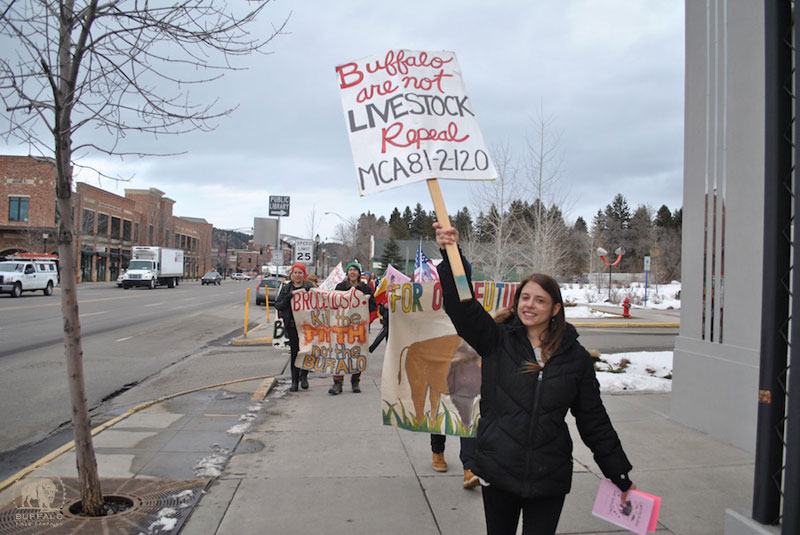
by Deep Green Resistance News Service | Feb 13, 2018 | Protests & Symbolic Acts
by Buffalo Field Campaign
Mark your calendars and plan to join Buffalo Field Campaign for some winter rallies for wild buffalo!
Yellowstone, Montana, and other bison managers have aims to kill upwards of 900 of the gentle giants this winter, all to appease Montana’s infamous livestock industry. The country’s last wild buffalo — a sacred and keystone species who is our National Mammal — are in dire straights and we must rally together to demand that they are protected and allowed to flourish, not be slaughtered to satisfy the whims of the cattle industry.

BFC Week of Action!
February 12 – 18, 2018
Join us for a series of gatherings, events, and rallies that we have planned for various towns near Yellowstone National Park. Dates, locations, and details are as follows:
Feb. 12, Monday, BFC Headquarters, West Yellowstone, MT
Kick off the week at camp with a meet-and-greet, orientation, and feast before we begin the week’s events.
Feb. 13, Tuesday, Gardiner, MT. First Annual Rosalie Little Thunder Memorial Walk
At 1:30 pm, gather at the Gallatin National Forest Gardiner Ranger District Office, 805 Scott St W, Gardiner, MT. We will begin our walk at 2:00 pm. We will walk through the town of Gardinger, past the Roosevelt Arch, and down Old Yellowstone Trail through Yellowstone National Park, The walk will end around 5:30, at the Beattie Gulch Trailhead, where we will share a meal and then hold a candlelight vigil in solidarity with wild buffalo and all of their advocates.
Feb. 14, Wednesday, Bozeman, MT. Rally Through Downtown
We will have an information table at the Bozeman Library, 626 E Main St, Bozeman, MT, from 11:00 a.m. – 4:00 p.m. We will gather banners, signs, and puppets, and march up and down Main Street throughout the day. Lunch and snacks will be provided.
Feb. 15, Thursday, BFC Headquarters. National Call-in Day and Day in the Field
A day of rest, direct action trainings, and field orientations for folks at camp. Everyone around the country and the globe will chime in and make Yellowstone’s and Montana’s phones ring off the hook as we hold our National Call-in Day. Targets and contact information will be forthcoming.
Feb. 16, Friday, Helena, MT. Rally at the State Capitol
Meet on the steps of the state capitol building, 1301 East Sixth Avenue, from 12:00 p.m. – 3:00 p.m. for a rally. We will have speakers from various Tribes, BFC, and other organizations to share their inspiration about wild buffalo. We anticipate drumming, singing, and story-telling. Possibly a visit to Governor Bullock’s office. Folks are also welcome to visit the office of the Montana Department of Livestock to share your feelings with them. A hot meal will be provided after the event. More details regarding speakers, etc., will be shared as available.
Feb. 17, Saturday, West Yellowstone, MT. Rally Through West Yellowstone
Meet at BFC Headquarters by 8:00 am for breakfast, or by 11:30 to carpool to town, or meet at Buffalo Spirit at 12:00, 14 N Canyon St, West Yellowstone, MT. From noon until 3:00 p.m., we’ll break out the banners, signs, drums, and puppets and march through the town of West Yellowstone, which is the most visited entrance to Yellowstone National Park.
Feb. 18, Sunday, BFC Headquarters. Gathering, Feasting, Trainings, and Story-Sharing
Enjoy a day in the field with the buffalo, learn from experienced activists, relish a delicious dinner, then share the stories and songs from your culture or your experiences, and learn from others. This close-down to our Week of Action is a bonding time that strengthens our solidarity as we move forward to defend the Earth from wherever we roam.
More information will be provided as we build these events. Please RSVP with our volunteer coordinators at volunteer@buffalofieldcampaign.org or call 406-646-0070. Bring friends, bring creative energy, bring your love for the wild!
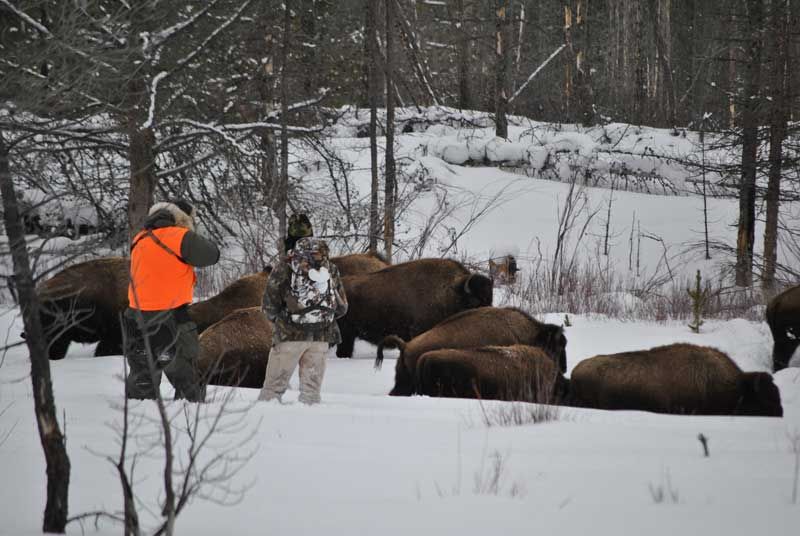
by Deep Green Resistance News Service | Feb 12, 2018 | Biodiversity & Habitat Destruction
by Max Wilbert / Deep Green Resistance
This morning, I spent four hours lost in an industrial neighborhood in Pocatello, Idaho. I was carrying two bags and a box full of food—altogether about 70 or 80 pounds—the wind was howling through the flat grey morning, and I must have covered five miles before I found the coffee shop that I’m sitting in right now.
Explaining why I am here requires that we go back almost 200 years. By the mid-1800’s, the U.S. empire was growing rapidly and expanding west. As guns and horses spread across the Great Plains, bison herds began to fall to hunters and settler-colonists in need of hides. At the same time, industrialism was expanding. Factories used buffalo leather straps as a strong yet elastic material to drive belts on their machines, which means that the bison were literally killed to drive machines.
By the year 1902, there were only 23 bison alive on this continent who took refuge in Pelican Valley in what is now Yellowstone National Park. This means that between 30 and 60 million had been killed in less than 100 years, most of them in less than 20 years. That’s a survival rate of less than one in ten million, or 0.0000007 percent.
The removal of the bison allowed cattle ranching to expand and allowed the U.S. army to force the powerful plains nations onto reservations. The removal of the native nations to reservations via a series of concentration camps allowed settlers to move in.
Over time, with the establishment of Yellowstone National Park and surrounding wilderness areas, the last 23 bison were able to expand their populations. Today, there are around 4,700 bison in the Yellowstone area who are direct descendants of those final 23 survivors.
At this point, you might be forgiven for thinking that as a society, we’ve learned better, and now we protect wild buffalo—especially within Yellowstone. The reality is the opposite. Over the past 33 years, government agencies including the National Parks Service and U.S. Fish and Wildlife Service have used our tax dollars to kill more than 10,000 wild bison in and around Yellowstone. In service of livestock interests, Yellowstone National Park has, in the words of my friend Stephany Seay, “more wild buffalo blood on their hands than anyone since the 19th century.”
Today the U.S. Government continues its 200-year-old war against the bison by herding, baiting, and hazing them into a trap located on the North Side of Yellowstone National Park. Here, they are kept for months, subjected to invasive medical procedures (including sterilization experiments), and then murdered. In the past few months, 169 bison have been killed (and counting).
The justification for this slaughter is misguided “management plans” which are heavily influenced—written, more or less—by the ranching industry lobbyists. As was true in the 1800’s, cattle reign supreme in Montana today, and bison pay the price. Idaho is the same. They have a “zero tolerance policy,” which means that any buffalo who enter Idaho are tracked down and killed.
Just so we’re clear, this slaughter is preventing the Yellowstone bison herds from naturally expanding their population into suitable habitat in adjacent National Forests. There is enough land and food and water for the bison, but the cattle barons want all of it
I’ve written and said many times before that we’re living in a war, and that the dominant culture (capitalism, industrialism, civilization, whatever you want to call it) is destroying the planet.
Most people in this culture don’t acknowledge this war, and as the saying goes, “silence is complicity.” Once you understand this war, continuing to stand aside is a betrayal to the planet. There are, however, thousands of people around the world who do acknowledge that this is a brutal war, and that we need to fight back.
These people include the organizers of Buffalo Field Campaign. Buffalo Field Campaign is a grassroots campaign that was founded by Lakota activist Rosalie Little Thunder and activist videography Mike Maese in the winter of 1996-7, when more than a thousand bison were slaughtered by the National Parks Service and Montana Department of Livestock.
Over the intervening 21 years, Buffalo Field Campaign has worked through advocacy, whistleblowing, lawsuits, and direct action to protect the last remaining wild bison in Yellowstone.
I’m on my way right now to Yellowstone. I don’t have a car to travel with, so I rented a one-way vehicle to Pocatello, where another group of friends will pick me up. There are seven or eight of us converging on Yellowstone to express our solidarity, bring donations and supplies, and join in the fight to protect bison.
I’ve often heard the saying that the life of a soldier is 99 percent waiting, and one percent overwhelming terror. In my experience, the life of a revolutionary organizer in the modern world is much the same. We need to prepare, write, organize, build our groups and political consciousness, and gain more resistance skills. Much of this work is boring, dangerous, or downright exhausting.
This morning, after driving through the day yesterday and sleeping on a friend’s grandmother’s couch (thanks for the bag lunch, Lois!), I woke up before 6, jumped in the car, and drove the middle leg of my trip. After dropping the rental car in a tiny, dingy office in the middle of an industrial park covered in trash and tumbleweeds, I had two options: sit awkwardly in the corner for a few hours, or shoulder all my bags, zip up my down jacket, grab my food box, and push open the squealing front door, and try to find my ways sans-GPS to a coffeeshop to get some writing done.
That’s why I was lost on the streets of Pocatello, Idaho this morning.









